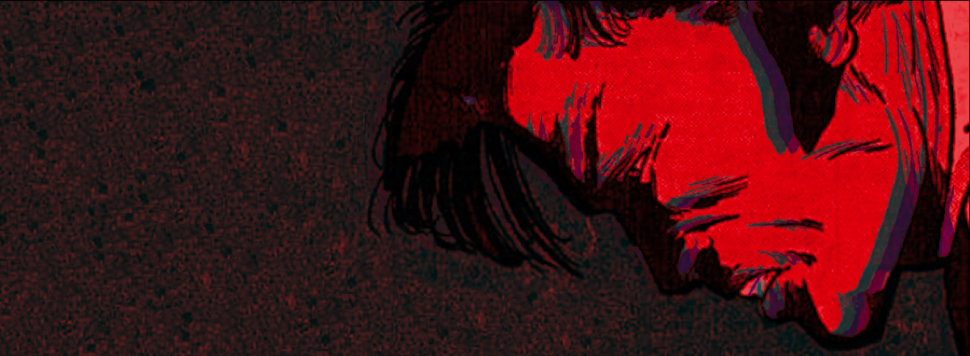The opening pages of Marvel’s Voices: Pride #1 from 2021 laid out the modern take on Marvel’s queer history, opening with Canadian superhero Northstar literally leaping at the reader in a recreation of the melodramatic moment everyone remembers from Alpha Flight #106, yelling “I AM GAY” at the top of his voice. The story goes on to retcon the Marvel Universe into an inclusive home for queer characters of all kinds that has always existed if you knew where to look.
The reality is less forgiving. Yes, Northstar had been queer-coded pretty much since his first appearance as an otherwise generic member of Alpha Flight all the way back in a 1979 issue of Uncanny X-Men, but the Marvel of that era was far from a welcoming, inclusive environment where anyone was free to live their truth. That much was made obvious a year later, with 1980’s Rampaging Hulk #23 introducing the closest thing the company had yet published to an openly gay character: two predators called Dewey and Luellen, who bully and harass a naked Bruce Banner in the showers of a local YMCA.
“You’re soft! And all pearly white — and you’ve got the cutest little cheeks!” Exclaimed Luellen as he pushed Banner against the wall. “Think he’ll whine, Dewey?” “Shush, sweetie! It’s alright! We just wanna play!” says Dewey elsewhere on the same page, as he pulls his top out of his pants, preparing to strip. “What’s your name, sweet cheeks, and where are you from? I like to know a fella, first!”
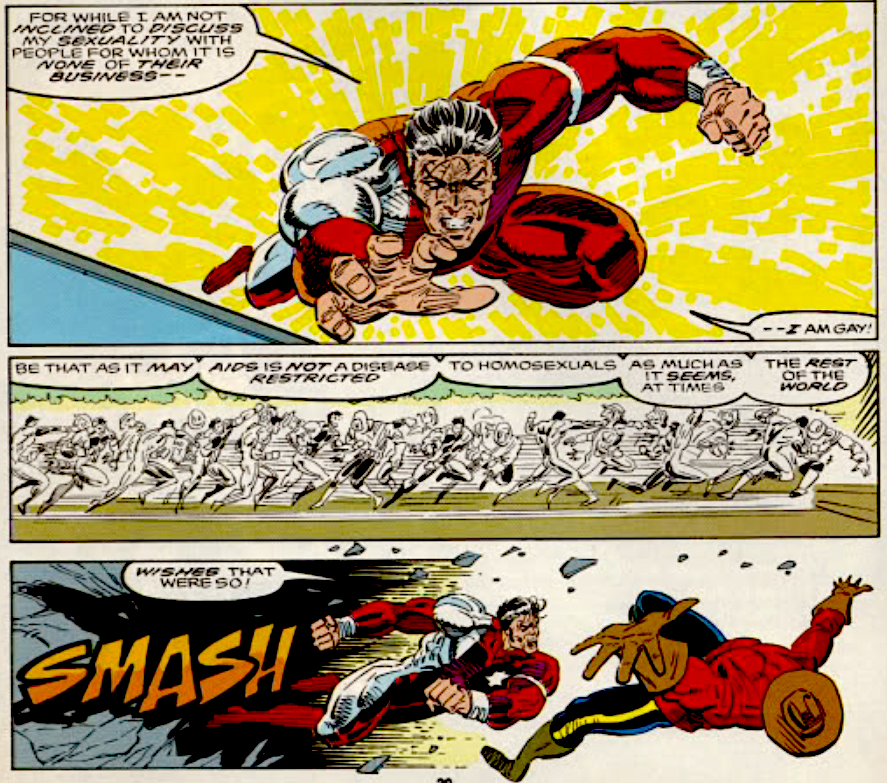
Needless to say, there’s a reason why this particular story won’t be showing up on your Marvel Unlimited anytime soon. And in case you’re wondering just how far up the chain this kind of homophobic attitude ran at the time, that was a comic written by the then-editor-in-chief of Marvel.
That same man, Jim Shooter, was still in charge of the publisher when Bill Mantlo took over the writing chores of the almost-hit series Alpha Flight with 1985’s #29. Mantlo was inheriting the comic from John Byrne, who’d created the characters, and he planned to shake things up with a plotline that was guaranteed to get people’s attention even as it harked back to the ripped-from-the-headlines glory days of Stan Lee back in the 1960s. Just as Lee has used the Amazing Spider-Man comic to write about student activism and drug use — with the latter prompting Marvel to break from the seemingly omnipotent Comics Code Authority for the first time — Mantlo wanted to write about what he saw as one of the biggest social issues of the era…and he was going to use Northstar to do it.
As he put it in an interview with queer news magazine The Advocate in 1987, “it would give me the opportunity to deal with a frightening, sad, controversial topic in a comic book — which I had always understood Marvel was all about.”
The topic Mantlo was referring to, of course, was the AIDS epidemic – a chronic disease that had been seeping its way into the population since the early 1970s, and had hit what appeared to be its peak in the mid-to-late 1980s. Not until 1982 was the term AIDS even coined, having previously been designated by the medical community as GRID (Gay Related Immune Deficiency) or, to put it more bluntly, “gay cancer”.
While we would all love to believe that medical logic wouldn’t discriminate, the steady traction of the Reagan-era conservatism and puritan thinking formed the perfect storm of religious indignation, ignorance, and hatred surrounding those who suffered from the disease and those who were believed to be the core demographic for spreading it. There are few things in history that have stigmatized gay men as much as the Reagan era and with over 85 thousand deaths to account for by the end of his presidency in 1989, and it’s a history that still haunts to this day. With stigma as a weapon, bigotry triumphed holding a trophy weighted with the bodies and hearts of the queer community as a whole.
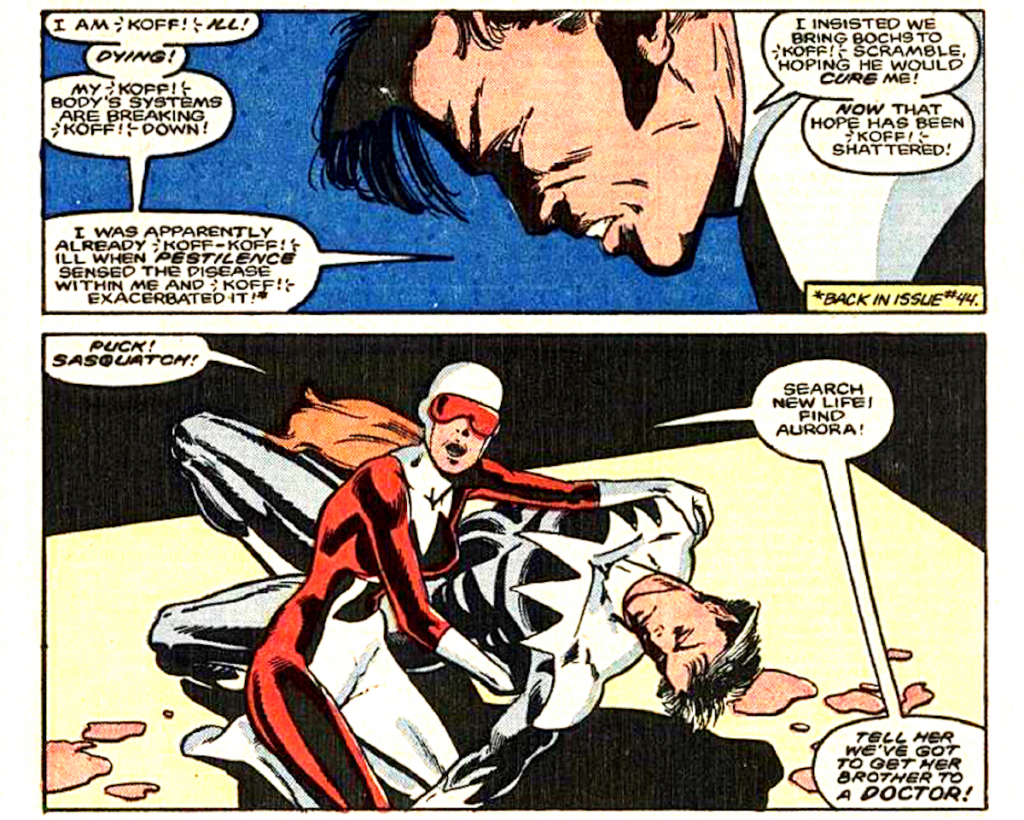
It shouldn’t be much of a surprise that Mantlo’s original plans got squashed in this regard, with the heavy hand of “hush up and let the dead die” still the prevailing narrative among the majority American population; as serious and deadly as the AIDS epidemic had become, the subject was shied away from across the majority of media of the period. 1985 might have seen the first two movies addressing the disease – indie drama Buddies, and NBC network drama An Early Frost – but it would be some years before writers and artists were fully able to share their stories with wider audiences. (Even the acclaimed Angels in America: A Gay Fantasia on National Themes wouldn’t debut until 1991, two years before the Academy Award-winning movie Philadelphia brought the topic to mainstream America via the comforting face of Tom Hanks.)
Regardless, what happened as a result is something that should remain a source of shame for Marvel for a long time to come, if not forever. It’s one thing to prevent Northstar from dying of AIDS, as was Mantlo’s original plan — it’s another to circumvent the plot so entirely that Northstar doesn’t even get to come out, but instead gets his entire backstory rewritten so that he actually ceases to be human altogether.
As Mantlo had planned it, Northstar would get sick after fighting a supervillain called Pestilence… and would have simply stayed sick for a period of some months. It would be a small thing at first — an inopportune cough, a bout of weakness — growing slowly but surely across months before the truth was finally revealed: Northstar would be revealed to have AIDS, and would ultimately die from the disease. In the process, both the Alpha Flight cast and the readers would have the opportunity to learn more about the reality of AIDS and the way it affected people physically and emotionally, and Northstar would finally be given the opportunity to come out… just before he passes away forever, one of the few Marvel heroes to die what was intended to be a permanent death. In hindsight, it’s far from the perfect queer narrative, but it’s also, undeniably, a story that was intended to mean something with good intentions.
It’s hardly surprising that The Powers That Be at Marvel refused to go along with it. As the story goes, Mantlo’s immediate editor got cold feet at the idea of, basically, outing a character as gay just to immediately kill him off. At roughly the same time, Marvel’s editor-in-chief (again, Jim Shooter, the mind behind Dewey and Luellen from before) finds out what Mantlo is planning for the first time and steps in to be far more emphatic in his objection: as far as he was concerned, Northstar was going to stay in the closet as long as possible, death or no death.
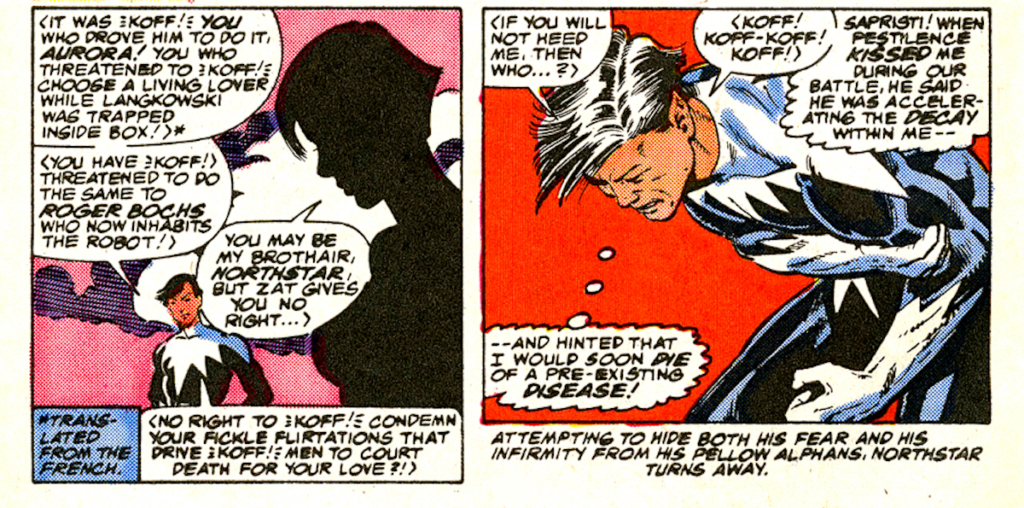
As Mantlo told The Advocate again shortly after all of this had gone down, “When the company found out what we were doing, an edict came down declaring that not only could Northstar not die of AIDS, but we couldn’t even have a gay character because it was too controversial! They were afraid too many people in the Bible Belt would stop buying the book and there would be all sorts of protests.”
This kind of censorship is something that has permeated comics since the start of the Comics Code – the overblown idea that something can be present, subversive, and even useful within a story, but only under specific regulations and within certain terms. After all, you can’t turn your head in the 1980s without hitting an X-Men comic where Mystique is definitely totally not a lesbian at all; or the well-meaning Wolfpack miniseries where gang violence was sanitized to the point of non-existence despite it being the prevailing them of the entire story. The quiet part can be there because we’re allies, but make sure you don’t say it truly out loud.

Regardless, there was just one problem: Mantlo had already started telling the story by the time word came that he wasn’t allowed to. Northstar had already fought Pestilence, and he was already coughing on panel quite a bit. It was clear to even the most forgetful reader that something was happening… but, suddenly, with Mantlo’s editor and editor-in-chief suddenly declaring that the original plot was off-limits, it wasn’t clear just why Northstar was getting sick, or what the end of the story was going to be. Something had to be done, and quickly — the storyline was already scheduled to be resolved in the 50th issue of the series, just months away.
A significant rewrite was obviously necessary. It remains somewhat unclear who came up with the plot line that finally saw print — although it’s perhaps notable that Mantlo would, less than a year after the comics’ release, describe the whole thing as “outrageous and anti-ethical to everything Marvel ever stood for” — but the end result was, for better or worse (it’s worse), worryingly in line with two bullies calling Bruce Banner “sweetie” in a communal shower stall, at least in spirit.
Northstar was getting sick… but not from AIDS. Nope. Instead, he was getting sick because he and his twin sister Aurora – a “sexy” cis, heterosexual woman who had notably seemed to be entirely healthy, if acting a little erratic this entire time – were actually not human at all, but “Light Elves” from the same mythical kingdom as Thor, who just happened to be… allergic to Earth. Apparently. Even though they’d been living there for decades just fine by that point in their lives, and Aurora wasn’t getting sick at all…? (This was written around at the time by retconning Aurora’s long-time multiple personalities into being proof that her Earth allergy was affecting her mind, instead of her body. Choices were made.) Instead of dying, he and Aurora simply choose to leave Earth and return to their own fantasy kingdom, instantly returning to perfect health in the process.
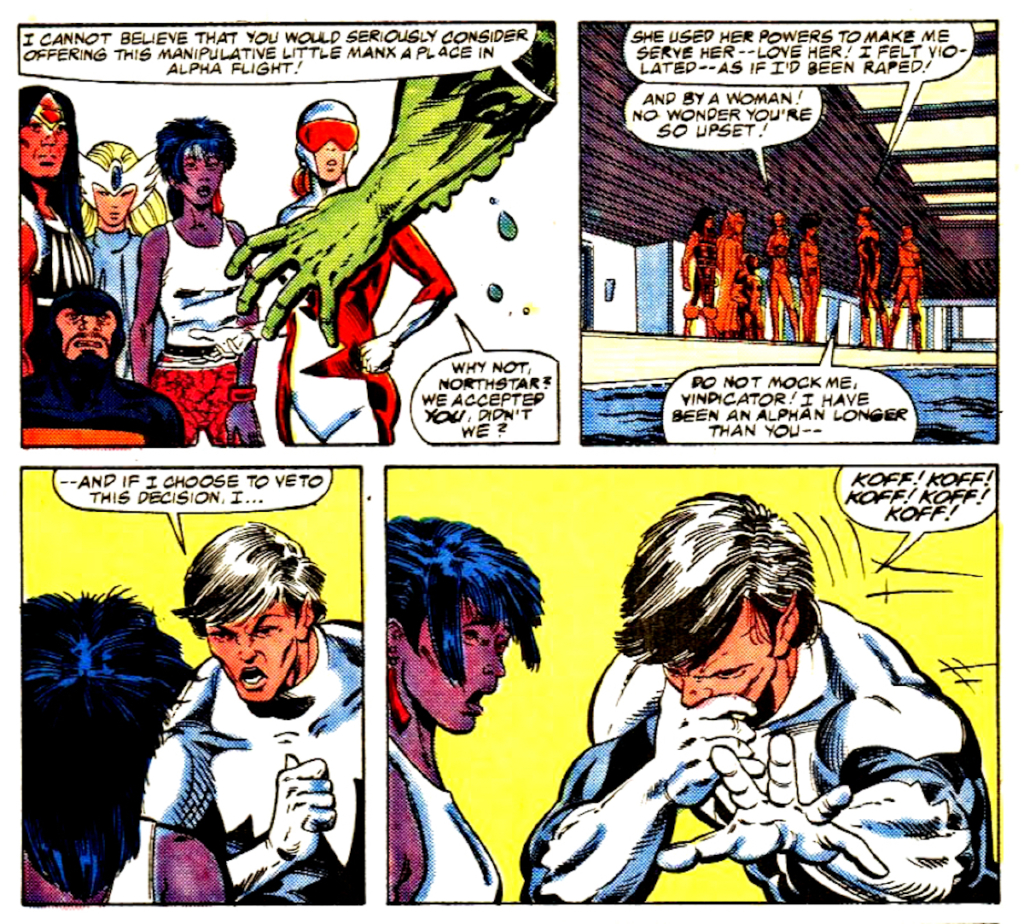
On the face of it, this seems inoffensive in its traditional “comic book”-y nature, until you realize that, in place of being allowed to write a story about a gay man’s experiences with AIDS, it becomes a story about, basically, a fairy getting sick from a fairy disease. Suddenly, the whole thing feels like a sick joke.
The last-minute changes didn’t go unnoticed, and by more than just regular Alpha Flight and Marvel fandom; beyond The Advocate, outlets like The Village Voice and sci-fi magazine Omni picked up the story, with Mantlo eagerly giving interviews about his upset. There’s a case to be made that mainstream magazines and newspapers were more interested in the story than the fan press, which might point to the hold that Marvel had over the latter at the time… or, depressingly, to the fact that not enough people cared about the AIDS epidemic or Marvel’s erasure of a character’s queerness at the time.
Marvel today would like to argue that it’s doing a far better job with regards to queer characters, and that’s true when looked at from some directions. There are multiple queer characters in Marvel’s comic book line-up, with Charlie Jane Anders recently taking over the New Mutants comic series to introduce a new trans character to the title – this is progression, right? This is a good thing! At the same time, there remain rumors of comic book plot lines quashed by editors for being “too queer,” or certain characters not being permitted to come out of the closet for fear of upsetting old school fans who like to fantasize about their heterosexual prowess — and that’s saying nothing about Marvel’s depressingly straight cinematic output, which prefers to queer bait fans instead of actually offer genuine, meaningful representation on the big screen. Even today, the Marvel Universe is only as inclusive and accepting as the people who own it are willing for it to be, and only within the confines of what makes for a story that can touch everyone, not just the people who might need it most in that moment.
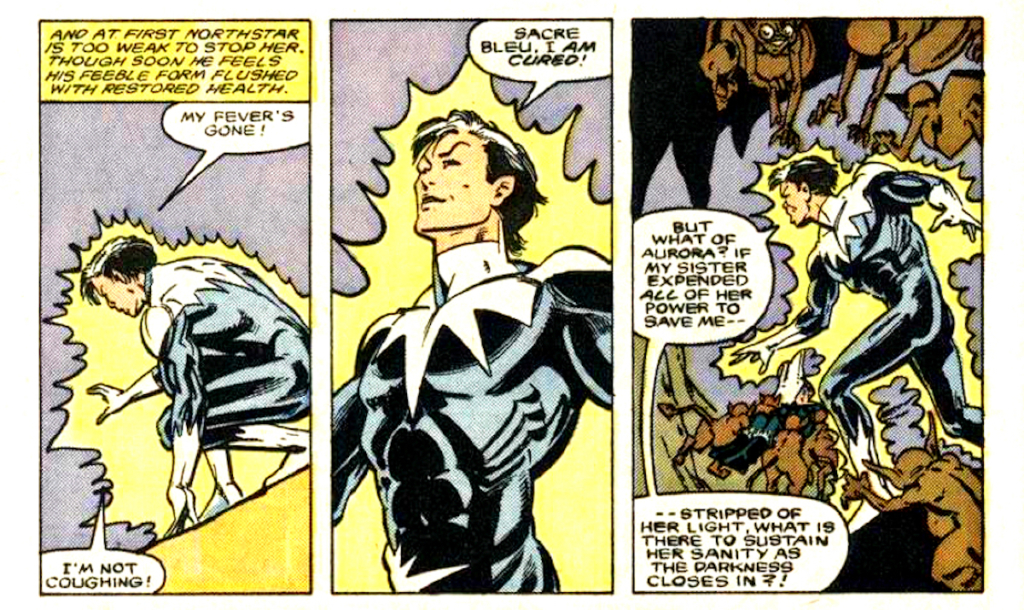
Something Mantlo said about the whole Northstar furore back in 1987 rings true even today. “Northstar couldn’t live as a gay character in comics, because it was too controversial, and he couldn’t die as one because it was too controversial,” he pointed out. “Quite honestly, I think it’s hypocritical and pointless, but that’s comics. You can’t do anything controversial even if it has integrity, even if it’s honest, even if it’s an attempt to deal with a serious issue affecting thousands of people and likely to affect millions more.”
To be a true believer is to see these fairy diseases, these tokens of alliance, and know that they are not enough now. But they are what we had for a while, and we can be grateful, in our own solemn way, for even having had that small fight for us to be human when no one else wanted us to be.
